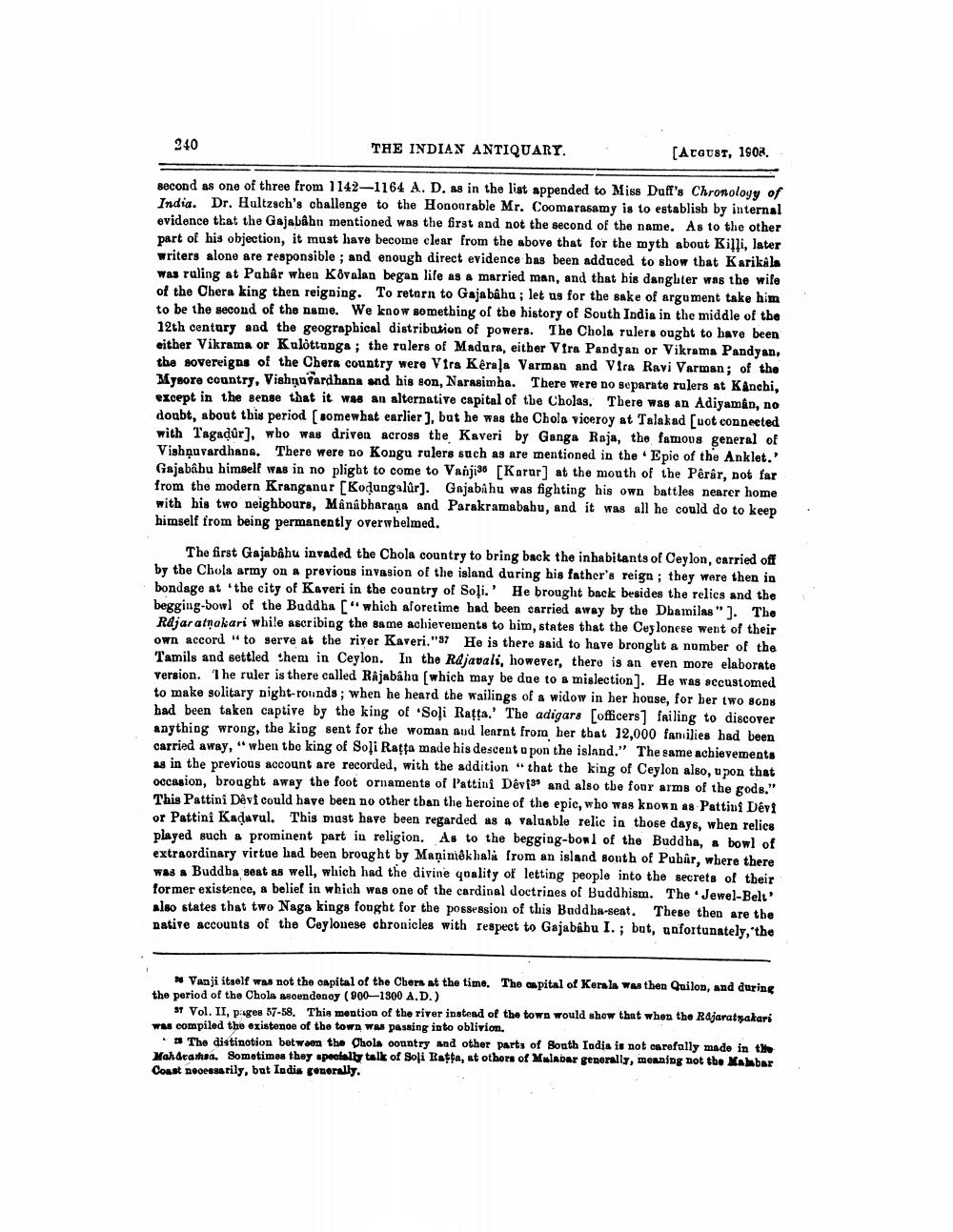________________
240
THE INDIAN ANTIQUARY.
[ATGUST, 1908.
second as one of three from 1142-1164 A. D. as in the list appended to Miss Duff's Chronoloyy of India. Dr. Hultzsch's challenge to the Honourable Mr. Coomarasamy is to establish by internal evidence that the Gajalâhn mentioned was the first and not the second of the name. As to the other part of his objection, it must have become clear from the above that for the myth about Killi, later writers alone are responsible ; and enough direct evidence has been adduced to show that Karikala was ruling at Pabâr when Kovalan began life as a married man, and that his danghter was the wife of the Chera king then reigning. To return to Gajabâhu ; let us for the sake of argument take him to be the second of the name. We know something of the history of South India in the middle of the 12th century and the geograpbical distribution of powers. The Chola rulers ought to have been either Vikrama or Kulottunga; the rulers of Madura, either Vfra Pandyan or Vikrama Pandyan, the sovereigns of the Chers country were Vira Keraļa Varman and Vira Ravi Varman; of the Mysore country, Vishņuvardhana and his son, Narasimha. There were no separate rulers at Kanchi, except in the sense that it was an alternative capital of the Cholas. There was an Adiyaman, no doubt, about this period (somewhat earlier ), but he was the Chola viceroy at Talakad (uot connected with Tagadůr], who was driven across the Kaveri by Ganga Raja, the famous general of Vishậuvardhana. There were no Kongu ralers such as are mentioned in the Epic of the Anklet.' Gajababu himself was in no plight to come to Vanji38 [Karur) at the mouth of the Pêrâr, not far from the modern Kranganar [Kodungalûr). Gajaba hu was fighting his own battles nearer home with his two neighbours, Mânâbharaṇa and Parakramabahu, and it was all he could do to keep himself from being permanently overwhelmed.
The first Gajabâhu invaded the Chola country to bring back the inhabitants of Ceylon, carried off by the Chola army on a previous invasion of the island during his father's reign; they were then in bondage at the city of Kaveri in the country of Soļi.' He brought back besides the relics and the begging-bowl of the Buddha ["which aforetime had been carried away by the Dhamilas"). The Rajaratnakari while ascribing the same achievements to him, states that the Ceylonese went of their own accord" to serve at the river Kaveri."37 He is there said to have bronglt a number of the Tamils and settled them in Ceylon. In the Rdjavali, however, there is an even more elaborate version. The ruler is there called Rajabahu (which may be due to a mislection). He was accustomed to make solitary night-rounds; when he heard the wailings of a widow in her house, for her two sons had been taken captive by the king of Soļi Ratta.' The adigars [officers) friling to discover anything wrong, the king sent for the woman and learnt from her that 12,000 families had been carried away, “when the king of Soļi Ratta made his descent a pon the island." The same achievements as in the previous account are recorded, with the addition that the king of Ceylon also, u pon that occasion, brought away the foot ornaments of Pattini Devi and also the four arms of the gods." This Pattini Devi could have been no other than the heroine of the epic, who was known as Pattini Devi or Pattini Kadavul. This must have been regarded as # valuable relic in those days, when relics played such a prominent part in religion. As to the begging-bowl of the Buddha, a bowl of extraordinary virtue had been brought by Manimêkhald from an island south of Pubär, where there was a Buddba sest as well, which had the divine quality of letting people into the secrets of their former existence, a belief in which was one of the cardinal doctrines of Buddhism. The Jewel-Belt' also states that two Naga kings fought for the possession of this Buddha-seat. These then are the native accounts of the Ceylonese chronicles with respect to Gajababu I. ; but, unfortunately, the
* Vanji itself was not the capital of the Chers at the time. The capital of Kerala was then Quilon, and during the period of the Chola aoendency (900-1300 A.D.)
57 Vol. II, puges 57-58. This mention of the river instead of the town would show that when the Rajaratsakari was compiled the existence of the town was passing into oblivion.
. The distinotion between the Chola country and other parts of South India is not onrefully made in the Mahdcama. Sometimes they specially talk of Soli Kafta, at others of MIAbar generalla, meaning not the Malabar Coast Decessarily, but India generally.




